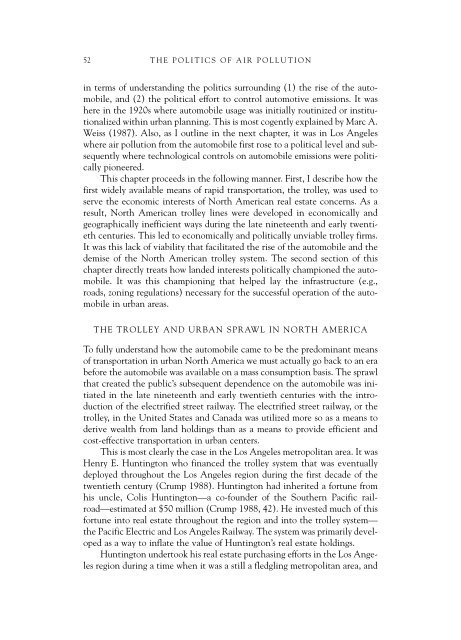GEORGE A. GONZALEZ - fieldi
GEORGE A. GONZALEZ - fieldi
GEORGE A. GONZALEZ - fieldi
You also want an ePaper? Increase the reach of your titles
YUMPU automatically turns print PDFs into web optimized ePapers that Google loves.
52THE POLITICS OF AIR POLLUTIONin terms of understanding the politics surrounding (1) the rise of the automobile,and (2) the political effort to control automotive emissions. It washere in the 1920s where automobile usage was initially routinized or institutionalizedwithin urban planning. This is most cogently explained by Marc A.Weiss (1987). Also, as I outline in the next chapter, it was in Los Angeleswhere air pollution from the automobile first rose to a political level and subsequentlywhere technological controls on automobile emissions were politicallypioneered.This chapter proceeds in the following manner. First, I describe how thefirst widely available means of rapid transportation, the trolley, was used toserve the economic interests of North American real estate concerns. As aresult, North American trolley lines were developed in economically andgeographically inefficient ways during the late nineteenth and early twentiethcenturies. This led to economically and politically unviable trolley firms.It was this lack of viability that facilitated the rise of the automobile and thedemise of the North American trolley system. The second section of thischapter directly treats how landed interests politically championed the automobile.It was this championing that helped lay the infrastructure (e.g.,roads, zoning regulations) necessary for the successful operation of the automobilein urban areas.THE TROLLEY AND URBAN SPRAWL IN NORTH AMERICATo fully understand how the automobile came to be the predominant meansof transportation in urban North America we must actually go back to an erabefore the automobile was available on a mass consumption basis. The sprawlthat created the public’s subsequent dependence on the automobile was initiatedin the late nineteenth and early twentieth centuries with the introductionof the electrified street railway. The electrified street railway, or thetrolley, in the United States and Canada was utilized more so as a means toderive wealth from land holdings than as a means to provide efficient andcost-effective transportation in urban centers.This is most clearly the case in the Los Angeles metropolitan area. It wasHenry E. Huntington who financed the trolley system that was eventuallydeployed throughout the Los Angeles region during the first decade of thetwentieth century (Crump 1988). Huntington had inherited a fortune fromhis uncle, Colis Huntington—a co-founder of the Southern Pacific railroad—estimatedat $50 million (Crump 1988, 42). He invested much of thisfortune into real estate throughout the region and into the trolley system—the Pacific Electric and Los Angeles Railway. The system was primarily developedas a way to inflate the value of Huntington’s real estate holdings.Huntington undertook his real estate purchasing efforts in the Los Angelesregion during a time when it was a still a fledgling metropolitan area, and









